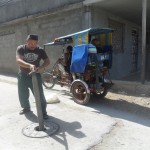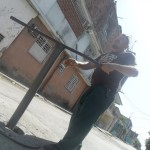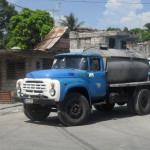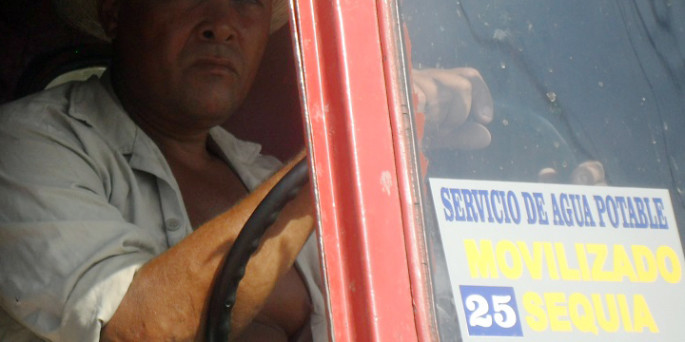
When the water doesn’t return to the earth
GUANTÁNAMO — Kirenia Ramírez always believed that Cubans were able to overcome anything, but now she has doubts.
When there was no soap, she scrubbed with sisal [agave fiber]; when there was a shortage of oil, she fried her food in coconut butter. She recycled old blouses into panties and made bedcovers and tablecloths with remnants of fabric.
When there are shortages of anything, a Cuban will always pull out an ace from his or her sleeve. But nothing — as far as we know — can replace water.
In recent weeks, Kirenia has been spending whole days collecting water, filling containers from faucets outside nearby buildings or outside homes around the corner.
“You may lack many things,” she tells me, “but you can’t understand the meaning of necessity until you have no water to shower, drink, wash your underwear, wash the dishes.”
When the liquid arrives, every seven days since July, life begins in the barrios of Cuba’s most populous city, even at 3 o’clock before dawn. People wash clothes, mop floors and collect as much water as they can in whatever containers they have — which most of the time are insufficient and precarious.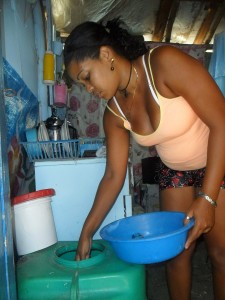
Kirenia owns a small tank made of green plastic, two smaller containers and several pans that she fills to the brim. She figures that should last for at least four days if nothing extraordinary happens, such as an unexpected family visit or stomach problems.
She lives in a shack of boards and a tin roof that she built on a family plot, all that remains of a house that burned down years ago, a wooden structure that saw better days and — had it not been for the fire — would have collapsed by now anyway.
Kirenia’s plight is one faced by thousands of Cubans. The National Institute of Water Resources estimates that more than 258,000 Guantanameros are experiencing the effects of the drought throughout the province. That estimate is laughable.
Kirenia is not included in that figure, even though she washes clothes every two weeks at her mother’s house, bathes thanks to the charity of neighbors and, once the water shortage became serious, sent her two children to spend the summer at their father’s house in Baracoa.
Some, of course, fare better than others. A few blocks away, María del Carmen Martínez has not yet felt the rigors of the drought. Her house, a two-family building, has five roof tanks with capacity for 5,000 liters of water [1,321 gallons], enough for a whole week or longer, if frugality is observed.
People in the building wash clothes every week and clean up every day. The family invested 200 convertible pesos (about 5,000 Cuban pesos or 200 dollars) in an additional tank, a kind of insurance in case the cycles of water distribution are expanded.
That kind of investment is not possible for everyone. The prices of tanks in the state-run stores range from 500 to 3,800 pesos depending on the capacity and the material. Tanks made of fiber-cement or plastic are the most sought-after and the most expensive.
Even if buyers bring cash, the demand for tanks is many times greater than the offer, to the point that out of six builders’ supply stores in Guantánamo only one carries them.
In the “informal market” often created outside the very same state-run stores, prices and offers are a lot more varied. Tanks range from the homemade reservoirs made of brass or cement to the same units that are sold in the stores, although at higher prices.
There’s good fishing in troubled waters
At the end of May, the month that marks the beginning of the rainy season in Cuba, the rain gauges in Guantánamo were already issuing an alarm that, one month later, was confirmed by the absence of rainfall.
According to the National Institute of Water Resources, June was the driest in the province since 1901, one of the driest months in the entire eastern region, defining a semester that was the driest since the turn of the 20th Century.
The result: a depression in the Faustino Pérez reservoir that shrank it to 5 percent of capacity, with little more than 4 million cubic meters of water, dangerously close to its “dead pool” level. According to the current distribution plan, Faustino Pérez is the main source of water for the city of Guantánamo, receiving some from the Yaya and Jaibo reservoirs, which still contain enough water.
In general, the reservoirs in the province are at 39 percent capacity, which still keeps Guantánamo out of the list of provinces closest to the “dead pool” level, among them Sancti Spiritus, Ciego de Ávila and Las Tunas.
Still, this is the worst drought in the memory of Eddy Cutiño, a 26-year valve operator for the Aqueducts & Sewage Authority, which oversees the 11 circuits in the center of town, one of the worst affected zones.
The biggest apportionments of water go to the “piperos” [water-truck drivers], be they state-hired drivers or owners of private trucks with an attached tank.
Under normal conditions, a “pipe” [tankful] of water (8 cubic meters = 2,114 gallons) costs up to 200 pesos but in drought conditions it costs 500 pesos (about 20 convertible pesos = 20 dollars), despite the controls announced by the Aqueducts & Sewage Authority.
In the barrios, young boys carry water to the neighbors charging 10 or 20 pesos per container, according to capacity, but in some neighborhoods they charge as much as 50 pesos.
Meanwhile, in the city, life goes on. Unlike previous years, very few commercial establishments have been shut down this year because of the drought. Private business owners are suffering, however.
Garden irrigation has not been affected so far, at least in Guantánamo City. But it could be stopped if rain doesn’t fall and the depression in the reservoirs worsens.
Palliative measures include the mobilization of dozens of water trucks, even modified tractors, to supply the districts worst affected. Elsewhere, the cycles of distribution have been expanded from every other day to every three days and, more recently, every seven days.
Behind closed doors, the future of the territory in terms of water supply is being defined. Specialists from the National Institute of Water Resources and the Aqueducts & Sewage Administration are looking for a more balanced distribution scheme.
One idea is to interconnect the city’s water mains to better handle the available water, says Alfredo Correa, NIWR delegate in the territory.
Investments being made include a program for the exploitation of subterranean water and the construction of several pumping stations. Such solutions would place Guantánamo in a better situation to deal with these adverse weather conditions that, apparently, are just beginning.
Photos taken by the author.
Progreso Weekly authorizes the total or partial reproduction of the articles written by our journalists, so long as source and author are identified.

